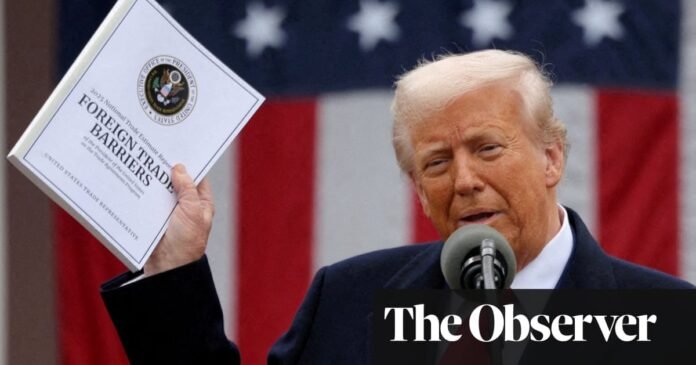Last week, Mao Ning, head of China’s foreign ministry information department, posted a blurry black-and-white clip of a moment in history. In 1953, Chairman Mao made a defiant speech of resistance to what he called US aggression in Korea.
Kim Il-sung, the North Korean leader and founder of the Kim dynasty, now in its third generation, had invaded US-backed South Korea. When Kim’s attempt to unite Korea by force appeared to be failing, China threw nearly 3 million “volunteers” into the war and succeeded in fighting to the stalemate that has prevailed ever since.
There was no mistaking the symbolism of the image. As Donald Trump bragged to his acolytes in Washington that foreign leaders were queuing up and “kissing my ass”, Beijing was announcing a “fight to the end”.
Trump may be about to discover that it is unwise to insult Beijing. The harder he plays it, the harder Beijing will play it back.
This determination to fight to the end is both rooted in China’s recent history and in concern for its future. Since the Chinese Communist party turned its guns on protesting students in Tiananmen in 1989, its propaganda has drummed the idea of a “century of humiliation” into generations of Chinese citizens.
The term is shorthand for the period between the first Opium war (1839-1842) and 1949, when the Communist party won China’s civil war. It was a period in which western imperial powers forced the ailing Qing dynasty to make concessions on trade and extraterritorial rights, followed by the collapse of the imperial dynasty and the invasion of China by Japan.
Since 1989, the “century of humiliation” has been central to the CCP’s message of aggrieved nationalism, and the promise to its citizens that the party would make China so rich and powerful that it would never again be bullied by foreign powers.
That promise has substantially been delivered. Globalisation, access to markets and foreign investment triggered three decades of double-digit growth that transformed China from a poverty-stricken rural society to an urbanised industrial power, even if the benefits of growth remain unevenly distributed. No longer the low-wage, low-added-value world factory of the 1990s, today’s China commands a lead across a range of advanced technologies and supply chains, including those essential for the energy transition, mid-range technology and defence.
China’s challenge now is to negotiate the more difficult waters of continuing growth. The economy is sputtering, the property sector collapse has left provincial governments mired in debt and short of revenue, and the industrial sector is producing far more than the domestic market can consume, despite a decade-long government effort to encourage more spending at home.
Industrial overproduction leads to ferocious cycles of competitive price cutting and growing resistance to what China’s trade partners increasingly see as dumping of cut-price goods in international markets. In China, successive shocks to the economy have made citizens anxious about the country’s future.But there is another useful thread in China’s propaganda that is coming to the aid of its beleaguered leadership: the long-running contest with the US for global power and influence, and the proposition that the US aims to contain China and sabotage its rise.
There is no shortage of evidence to support the thesis: a decade of mounting, bipartisan hostility in Washington; a succession of defence and security reviews that cite China as America’s principal strategic threat; restrictions on sales to China of advanced semiconductors to slow its technological advance,; and now Donald Trump’s trade war.Economically, the trade war may be bad news for Xi Jinping, but ideologically and politically it is a gift.
In 1989, the student protesters in Tiananmen erected a statue they called the Goddess of Democracy. It was a replica of the Statue of Liberty, and their message to the Chinese leadership could not have been clearer. Today, young Chinese people are flooding digital platforms with satirical TikTok videos of an obese Trump in a dress dancing with Elon Musk, or struggling to assemble goods on a production line.
In recent years, iPhones and Teslas became status symbols for the increasingly well-heeled Chinese middle class. Today, driving a BYD electric car and carrying a Xiaomi mobile phone are as much symbols of national pride in China’s technological advance as the troupe of dancing robots that entertained viewers in January’s New Year TV spectacular, or news of China’s latest space shot.
And if times are hard for China’s laid-off workers or job-hunting graduates, Xi can blame Trump and rally the nation to resist this latest round of US aggression.
Hardship created by a government that mishandles the economy is a political problem. Hardship generated by a hostile external power can easily become an asset.
During Trump’s first presidency, tariffs and export restrictions spurred China to greater self-reliance and domestic innovation. This latest round will reveal the depth of mutual dependency and how much reciprocal pain each side can inflict on the other.
China’s leadership did not choose the fight, but it now believes that there are considerable gains to be made in this deadly contest for global influence. Isabel Hilton is a London-based writer and broadcaster who has reported extensively from China and Hong Kong





